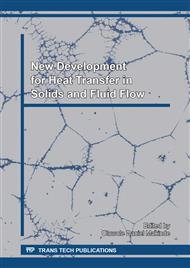[1]
J. Bebernes, D. Eberly, Mathematical problems from combustion theory, Springer, New York, NY, USA, (1989).
Google Scholar
[2]
Z.G. Szabo, Advances in kinetics of homogeneous gas reactions, Methuen and Company, Great Britain, UK, (1964).
Google Scholar
[3]
D. A. Frank Kamenetskii, Diffusion and heat transfer in chemical kinetics, Plenum Press, New York, NY, USA, (1969).
Google Scholar
[4]
O. D. Makinde, On the thermal decomposition of reactive materials of variable thermal conductivity and heat loss characteristics in a long pipe, Journal of Energetic Materials, 30(4) (2012) 283–298.
DOI: 10.1080/07370652.2011.566598
Google Scholar
[5]
G. I. Barenblatt, J. B. Bell, W. Y. Crutchfield, The thermal explosion revisited, Proceedings of the national academy of sciences of the USA, 95(23) (1998) 13384–13386.
DOI: 10.1073/pnas.95.23.13384
Google Scholar
[6]
O. D. Makinde, Exothermic explosions in a slab: a case study of series summation technique, International Communications in Heat and Mass Transfer, 31(8), (2004) 1227–1231.
DOI: 10.1016/j.icheatmasstransfer.2004.08.020
Google Scholar
[7]
E. Balakrishnan, A. Swift, G. C. Wake, Critical values for some non-class A geometries in thermal ignition theory, Mathematical and Computer Modelling, 24(8) (1996) 1–10.
DOI: 10.1016/0895-7177(96)00133-1
Google Scholar
[8]
F. A. Williams, Combustion theory, Benjamin & Cuminy publishing, Menlo Park, Calif, USA, 2nd edition, (1985).
Google Scholar
[9]
C. Lohrer, U. Krause, J. Steinbach, Self-ignition of combustible bulk materials under various ambient conditions. Process Saf Environ., 83 (2005) 145–150.
DOI: 10.1205/psep.04234
Google Scholar
[10]
J. D. Buckmaster, G. S. S. Ludford, Theory of laminar flames, Cambridge University Press, (1982).
Google Scholar
[11]
O. D. Makinde, Hermite-Pade´ approach to thermal stability of reacting masses in a slab with asymmetric convective cooling, Journal of the Franklin Institute-Applied Mathematics and Engineering 349 (3), (2012) 957–965.
DOI: 10.1016/j.jfranklin.2011.12.001
Google Scholar
[12]
R. S. Lebelo, O. D. Makinde, T. Chinyoka, Thermal decomposition analysis in a sphere of combustible materials. Advances in Mechanical Engineering, 9(2) (2017) 1-14.
DOI: 10.1177/1687814017692515
Google Scholar
[13]
O. D. Makinde, Thermal stability of a reactive viscous flow through a porous-saturated channel with convective boundary conditions, Applied Thermal Engineering, 29(8/9), (2009) 1773–1777.
DOI: 10.1016/j.applthermaleng.2008.08.012
Google Scholar
[14]
A. N. Garcia, R. Font, Thermogravimetric kinetic model of the pyrolysis and combustion of an ethylene-vinyl acetate copolymer refuse, Fuel, 83, (2004) 1165-1173.
DOI: 10.1016/j.fuel.2003.10.029
Google Scholar
[15]
T. S. Fischer, N. Eisenreich, A. Pfeil, Kinetic parameters of the thermal decomposition of trimethylindium by DSC, ThermochimicaActa, 339 (1999) 35-40.
DOI: 10.1016/s0040-6031(99)00295-6
Google Scholar
[16]
O. D. Makinde, M. S. Tshehla, Analysis of thermal stability in a convecting and radiating two-step reactive slab, Advances in Mechanical Engineering, 2013 (2013) Article ID 294961pp1-9.
DOI: 10.1155/2013/294961
Google Scholar
[17]
F. S. Dainton, Chain reaction: An introduction, John Wiley & Sons, New York, NY, USA, (1960).
Google Scholar
[18]
N. N. Semenov, Chemical kinetics and chain reactions, The Clarendon Press, Oxford, UK, (1935).
Google Scholar
[19]
J.M. Simmie, Detailed chemical kinetic model for the combustion of hydrocarbon fuels. Prog Energ Combust 29 (2003) 599–634.
DOI: 10.1016/s0360-1285(03)00060-1
Google Scholar
[20]
A. Arisoy, B. B. Beamish, E. Cetegen, Modelling spontaneous combustion of coal. Turk J EngEnv Sci. 30 (2006) 193–201.
Google Scholar
[21]
S. Lebelo, O. D. Makinde, Modelling the impact of radiative heat loss on CO2 emission, O2 depletion and thermal stability in a reactive slab. Iranian Journal of Science and Technology, Transactions of Mechanical Engineering, 39, No. M2, (2015).
Google Scholar
[22]
S. Lebelo, O. D. Makinde, Numerical investigation of CO2 emission and thermal stability of a convective and radiative stockpile of reactive material in a cylindrical pipe. Advances in Mechanical Engineering, 7(12) (2015) 1–11.
DOI: 10.1177/1687814015620323
Google Scholar
[23]
T. Chinyoka, O. D. Makinde, Computational analysis of CO2 emission, O2 depletion and thermal decompositionin a cylindrical pipe filled with reactive materials. Commun Nonlinear Sci. 18 (2013) 2448–2461.
DOI: 10.1016/j.cnsns.2013.01.018
Google Scholar
[24]
T. Cebeci, P. Bradshaw, Physical and computational aspects of convective heat transfer, Springer, New York, USA (1988).
Google Scholar


